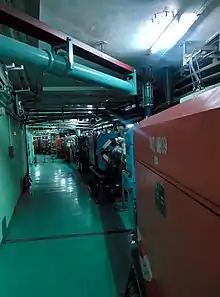Beijing Electron–Positron Collider II
The Beijing Electron–Positron Collider II (BEPC II) is a Chinese electron–positron collider, a type of particle accelerator, located in Shijingshan District, Beijing, People's Republic of China. It has been in operation since 2008 and has a circumference of 240.4 m.[1]

It was intended as a charm factory and continues the role of CLEO-c detector. The center of mass energy can go up to 4.6 GeV with a design luminosity of 1033 cm−2·s−1.[2] Operations began in summer 2008 and the machine has run at multiple energies.
History

The construction of the original Beijing Electron Positron Collider was approved in 1983, as China was emerging from the Cultural Revolution, based on a proposal developed by Xie Jialin, who went on to oversee the construction of the machine. The construction of this collider was considered so important that then vice-premier Deng Xiaoping attended the groundbreaking in 1984 and returned in 1988 as the machine neared operation.[3][4][5]
The original Beijing Electron Positron Collider was commissioned in 1989 and decommissioning began in 2000 as plans were developed for BEPC II, although operation continued until 2004. The shape of the BEPC has been described as a tennis racquet, with a linac with a beam energy of from 1.5 to 2.8 GeV serving as the handle, injecting counter-rotating beams of particles into a storage ring at the head, giving collision energies in the range from 3.0 to 5.6 GeV. The BEPC was built to investigate tau-charm physics, using the Beijing Spectrometer. Major accomplishments of the original BEPC included precision measurement of the Tau mass.[6][7][8]
BES III
The BES III (Beijing Spectrometer III) is the main detector[9] for the upgraded BEPC II.
BES III uses a large superconducting solenoid to provide a 1-tesla magnetic field, and also features a helium gas-based tracking chamber and an electromagnetic calorimeter using 6240 caesium iodide crystals.
References
- "Beijing Electron Positron Collider (BEPC)". Institute of High Energy Physics Chinese Academy of Sciences. 2004-01-09. Archived from the original on 2016-03-16. Retrieved 2015-10-15.
- BESIII Collaboration (17 Aug 2009). "Charm Factories: Present and Future". AIP Conference Proceedings. 1182 (1): 406–409. arXiv:0908.2157. Bibcode:2009AIPC.1182..406Z. doi:10.1063/1.3293832. S2CID 118363265.
- Matin Durrani, Pushing the Boundaries, Physics World, 15 Sep 2011.
- Min Zhang and Qian Pan, Jialin Xie wins China’s top science award, International Linear Collider Newsline, 23 February 2012.
- Deng Xiaoping, China Must Take Its Place In the Field of High Technology, Oct. 24, 1988, The Selected Works of Deng Xiaoping
- Future Plans Take Place in Beijing, Cern Courier, 30 October 2000.
- Zheng, Zhipeng (1993). "The Present and Future of China's Particle Physics Research". Science. 262 (5132): 368. Bibcode:1993Sci...262..368Z. doi:10.1126/science.262.5132.368. PMID 17789941.
- Hübner, K.; Ivanov, S.; Steerenberg, R.; Roser, T.; Seeman, J.; Oide, K.; Mess, Karl Hubert; Schmüser, Peter; Bailey, R.; Wenninger, J. (2020). "The Largest Accelerators and Colliders of Their Time". Particle Physics Reference Library. pp. 585–660. doi:10.1007/978-3-030-34245-6_10. ISBN 978-3-030-34244-9. S2CID 219874352. See Table 10.11, Historical listing of electron-electron and electron-positron colliders
- "Minnesota BES-III home page". Archived from the original on 2010-09-01. Retrieved 2010-10-23.
External links
Record for BEPC-BES II experiment on INSPIRE-HEP